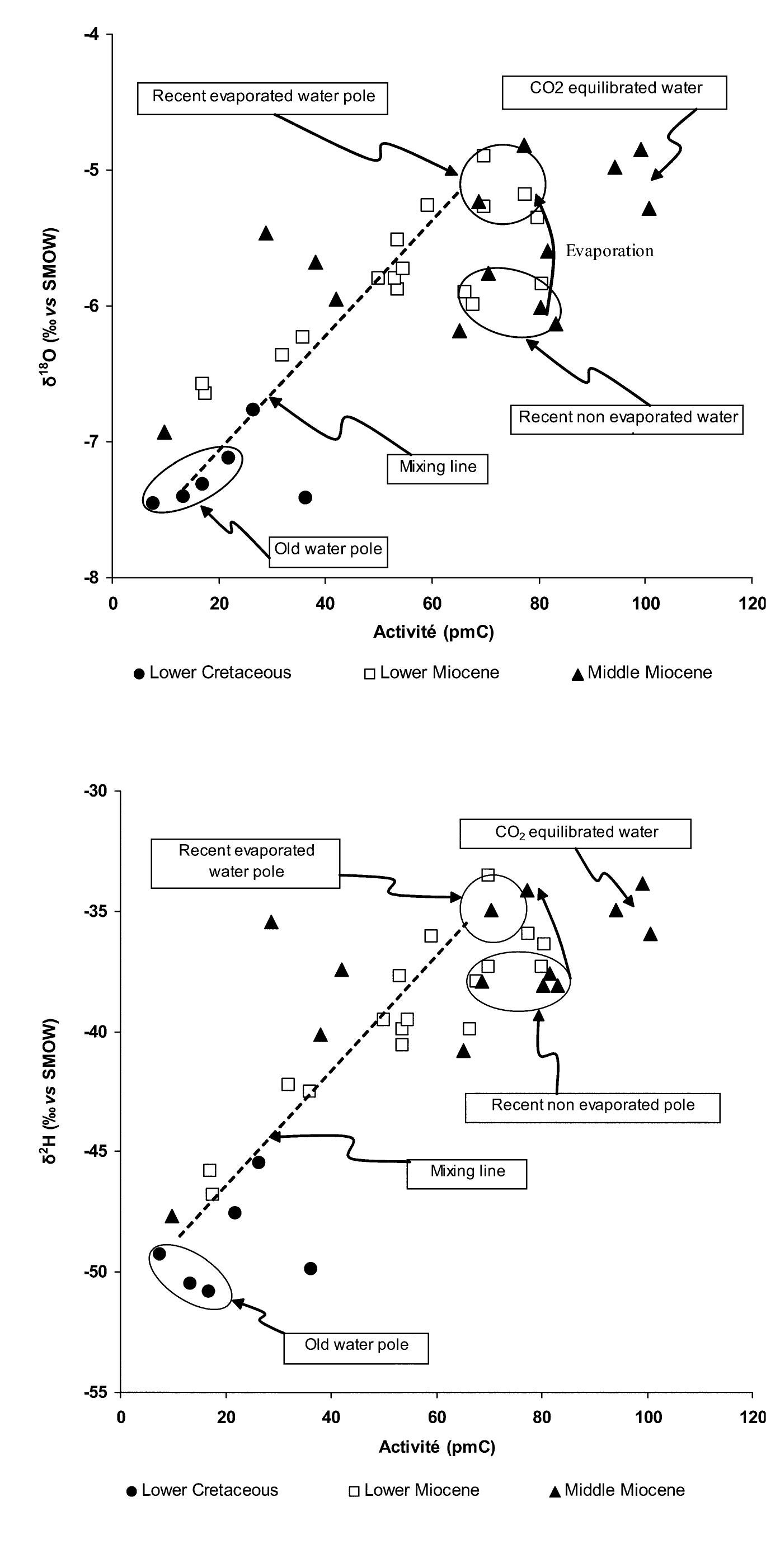Flow exchange between the deep and shallow groundwaters in the Sbe? tla synclinal basin (Tunisia): an isotopic approach (original) (raw)
AI-generated Abstract
Stable (18O, 2H) and radiogenic (3H, 14C) isotopes of water have been used to constrain the source, origin, age, migration pathway and mixing processes in the Sbeı¨tla (Tunisia) system. The system is composed of an upper unconfined 'Middle Miocene' aquifer with a variable thickness from 10-300 m, an intermediate confined/unconfined 'Lower Miocene' aquifer about 100 m thick and a deeper confined 'Lower Cretaceous' aquifer about 150 m thick separated by a thin clay layer. A total of 53 groundwater samples from the three aquifers and spring samples were collected during February and March 2000 and isotopically analysed using conventional methods. The stable isotopes composition of waters establishes that the deep groundwater (depleted as compared to present corresponding local rainfall) is ancient water recharged probably during the late Pleistocene and the early Holocene periods. The relatively recent water in the superficial aquifer is composed of mixed waters resulting presumably from upward leakage from the deeper groundwater. The radiogenic (3H, 14C) isotopes data confirm that the recent water, with a tritium content between 6.5 and 19 TU, represents post-nuclear recharge and the ancient groundwater with low carbon-14 contents between 7 and 26 pmC infiltrated between 8,000 to 20,000 years ago. When used in conjunction with the stable isotopes data, the mixing process can be clearly identified, especially in the Sbeı¨tla sill area. Groundwater of the upper aquifer exhibits isotopic signatures of both the old and recent waters. By using isotopic mass balance, the computed contribution of the deep groundwater in recharging the upper aquifer is up to 94%. Associated with extensive groundwater use are several deleterious consequences which have severely intensified over time. They include water level decline in both Miocene aquifers and their corollaries of drying springs, loss of artesian condition and water quality degradation presumably due to mixing with deep mineralized (up to 2.5 g/L) Lower Cretaceous groundwater. These consequences interfere with the prudent use of these invaluable resources on a 'sustainable' basis. An understanding of the origin, sources, ages, migration pathway and mixing rates is therefore necessary for viable long-term development. Major and minor ion chemistry is of limited value when dealing with these issues. They are however worthwhile in identifying the geochemical reactions occurring in the aquifer system.
Figures (9)
Fig. 1 Geologic map of the Sbeitla basin
graphic units during February and March 2000. A total of 53 samples were collected from springs, shallow dug wells (20-35 m depth) and deep boreholes (90-500 m depth) (Fig. 3). ae ~ Stable isotope ratio ('%O/'°O and 7H/'H) analyses were performed at the GSF-Institute of Groundwater Ecology (Germany) by using standard methods. Hydrogen and oxygen isotope analysis were made by respectively employing the standard CO» equilibration Epstein and Mayeda 1953) and the zinc reduction echniques (Coleman and others 1982), followed by analysis on a mass spectrometer. All oxygen and hydrogen isotopes analysis are reported in the usual 6 notation relative to Vienna Standard Mean Oceanic Water (VSMOW) standard, where 6= [(Rs/Rsmow)— I]x 1,000; Rs represents either the '$0/'°O or the “H/'H ratio of the sample, and Rsmow is 18g/"O or the ?H/'H
Fig. 3 Sampling wells network
ities range between 7 and 26 pmC with one well exhib- iting 36 pmC. The relatively high ““C activities measured in most han 18 TU, which is an indication of post-nuc charge water. The relatively low '*C activities be and 26 pmC associated with low *H contents parts of the Lower and Middle Miocene groundwaters suggest a local young recharge source. These ground- waters exhibit *H contents ranging from 1.35 to more ear re- ween 7 in the Lower Cretaceous groundwater give a clear ind ication hat these waters are ancient. The computed age of the deep groundwater using uncorrected values ranges from 8,000 to 20,000 years ago. i Groundwater samples with low to intermediate “*C activities (9.7-60 pmC) and variable *H contents (0.7— 1.25 TU) suggest a probable mixing of old and recent groundwaters. These waters which retain the isotopic signatures of both old and recent groundwaters are exclusively located in the Sbeitla hydraulic sill zone where differences in heads allow upflow leakage of the deep aquifer towards the shallow ones. _ Plots of stable isotopes ('*O and *H) versus '*C activities (Figs. 7 and 8) clearly evidenced the mixing process in parts of the aquifer system. They showed distinguishable patterns related to mixing, evaporation
Table 2 Isotope contents and deep groundwater contribution in the Miocene aquifers and atmospheric CO, equilibration processes. In the mixing line between the old water pole and the recent water pole, the Lower and Middle Miocene wells close to the old water pole are located near the Sbeitla fault and the Mrhila Jebel both acting as barrier to the groundwater flow.
Fig. 9 Deep groundwater computed contribution vs. isotope contents

Loading Preview
Sorry, preview is currently unavailable. You can download the paper by clicking the button above.

![graphic units during February and March 2000. A total of 53 samples were collected from springs, shallow dug wells (20-35 m depth) and deep boreholes (90-500 m depth) (Fig. 3). ae ~ Stable isotope ratio ('%O/'°O and 7H/'H) analyses were performed at the GSF-Institute of Groundwater Ecology (Germany) by using standard methods. Hydrogen and oxygen isotope analysis were made by respectively employing the standard CO» equilibration Epstein and Mayeda 1953) and the zinc reduction echniques (Coleman and others 1982), followed by analysis on a mass spectrometer. All oxygen and hydrogen isotopes analysis are reported in the usual 6 notation relative to Vienna Standard Mean Oceanic Water (VSMOW) standard, where 6= [(Rs/Rsmow)— I]x 1,000; Rs represents either the '$0/'°O or the “H/'H ratio of the sample, and Rsmow is 18g/"O or the ?H/'H](https://figures.academia-assets.com/50995345/figure_002.jpg) ](
](





